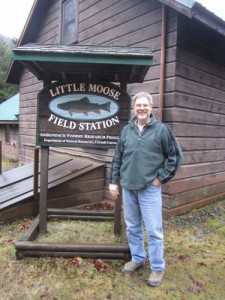The late Dr. Dwight Webster, a professor of Fishery Biology at Cornell University, first came to the Adirondack League Club (ALC) in 1950 as a private consultant.
At the time, fishing throughout the Adirondacks had declined greatly for a number of reasons and his mission as a consultant was to improve the fishing in local ponds, lakes and streams.
He was later invited to consult in other Adirondack locations as well, and his work developed into a major research program with involvement by Cornell University and a broader base of landowners.
With a field station at the Adirondack League Club (ALC), this Adirondack fisheries research program is still going strong 62 years later.
In the 1950’s to1960’s, the effects of acid rain were already being felt, but the problem had not been identified.
Studies on fish were a relatively easy place to begin in identifying the effects of acid rain on water bodies.
Dr. Webster and the ALC kept records from the 1950’s, before others began doing so.
Records of their water sample tests, fish surveys, and other measured data were recognized as invaluable when Adirondack water bodies became devoid of fish.
Their records of changes in pH values of water over time brought increased understanding to the problem.
Dan Josephson, who currently heads the program, was a student of Dr. Webster’s at Cornell where he earned a BS degree in Biology and Fisheries.
Upon his 1979 graduation, he was hired by Dr. Webster to work with him at ALC.
After a year and a half, Josephson left the area to attend graduate school at Virginia Tech.
Then, with a Masters degree in hand, he returned to the area and worked on acid rain research projects at Cornell’s Eagle Bay field station for four years. Among his projects was the study of lake liming.
In 1987, he signed on with the long-term Adirondack Fishery Research Program and has been managing Cornell’s field station at the Adirondack League Club ever since.
As manager, he conducts independent research and works along with undergraduate and graduate students from Cornell, and other universities, on their projects.
The field station does collaborative studies with a number of academic institutions and agencies, including Syracuse University, Penn State, Colgate and University of Minnesota.
They also work with the Department of Natural Resources, the DEC, the U.S. Geological Survey and other agencies. Josephson said collaborations with outside agencies are especially productive when one party has manpower and resources and another has funding.
The team does both in-kind and contract work.
They bring in scientists with varied expertise to address the ecosystem as a whole including bird specialists, land and water specialists, and those working with aquatic invertebrates, among others.
An example of the positive outcome of the work executed by Josephson and his colleagues is the increase in the brook trout population of Honnedaga Lake since 1990.
Research done in the 1980’s led to amendments to the Clean Air Act, including more stringent emissions controls.
Brook trout are a heritage (native) species that had its population decimated by the introduction of invasive species.
One of the current issues being addressed through the research program is the presence of high concentrations of airborne mercury.
Josephson said that mercury sources include the burning of fossil fuels and solid waste such as hospital waste.
While solid waste may not be burned locally, the mercury created from far-away sources remains airborne for long distances and drops when it hits tall land rises, such as the the Adirondack Mountains.
Methyl mercury is a dangerous form of mercury that is created when bacteria converts total mercury in low pH, high dissolved organic carbon (DOC) environments, Josephson said.
The brown water we see in Adirondack wetlands is the perfect “cauldron” for creation of methyl mercury, which is then transported up the food chain.
Loons are among species that have been identified with high levels of mercury in their blood.
Mercury levels of certain fish species are so high that a fish consumption advisory has been issued by the New York State Department of Environmental Conservation (NYS- DEC).
Pregnant women and children under 15 are advised against eating any perch, bass or Northern Pike caught in the Adirondacks. This has been the case for approximately six years.
Adult males and non-pregnant females should follow a general consumption advisory, which can be found on the DEC website.
Josephson said there has always been an advisory for limitations on consumption of wild-caught fish, due to biomagnification of unhealthy contaminants.
But in the Adirondacks, there is an actual “Do not eat” list of species which contain even a greater magnification of harmful contaminant.
Named to the list are piscivorous, or fish-eating fish.
“The big issues for fisheries in the Adirondacks continue to be acid rain coupled with mercury. They’re pretty tightly linked. And potentially, climate change is another,” Josephson said.
While the Cornell researchers at the ALC fishery site don’t study climate change per se, they look at the effect of temperatures on brook trout spawning and on fish populations.

